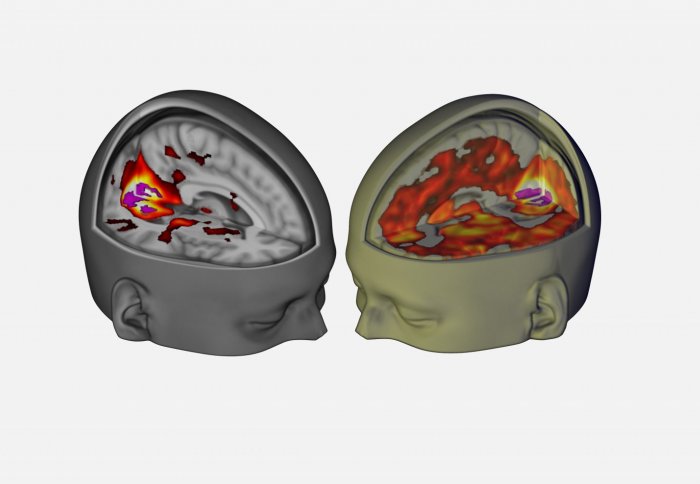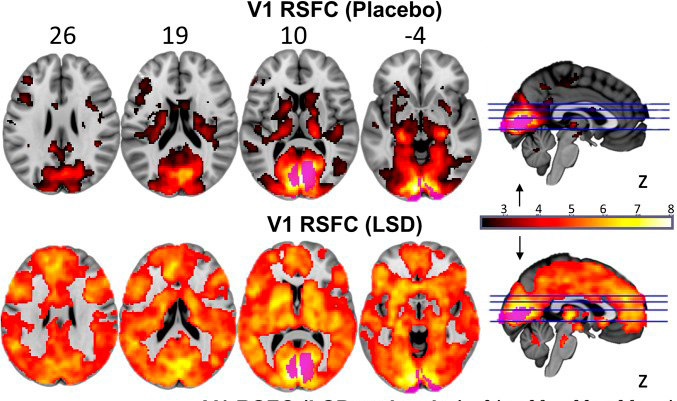What actually happens inside your brain when you take LSD?
For decades, we’ve had theories, poetry, and first-hand tales from psychedelic voyagers… but until recently, no one had the full picture from a scientific point of view. That changed when researchers at Imperial College London pulled off a historic first: they scanned the human brain during a full-blown LSD experience, using not one, but three different neuroimaging technologies.
And the results? Nothing short of mind-blowing.

under LSD (right), which was linked to hallucinations
Seeing Without Eyes: LSD Lights Up the Visual Cortex
One of the most immediate effects of LSD is its ability to produce vivid, even overwhelming visuals, often with your eyes closed. Turns out, this isn’t just “in your head.” The scans showed a massive surge of blood flow to the visual cortex—the part of your brain responsible for processing sight.
But here’s the wild part: this increase in activity wasn’t caused by any external visuals. It came from within. People were seeing vibrant patterns, geometric shapes, and even entire scenes from memory—all while lying still, with their eyes closed inside a scanner. In essence, LSD supercharges the imagination and turns up the brightness on your internal projector.

The Default Mode Network: From Control Center to Cosmic Playground
Another area that LSD had a massive impact on is something called the Default Mode Network—a kind of command center in the brain that’s tied to our sense of self, or ego. Under the influence of LSD, this normally tight-knit network becomes disintegrated. Its parts stop talking to each other the way they usually do and start connecting to other, unexpected regions.
This breakdown in internal boundaries is thought to be a major reason why people report losing their sense of ego or feeling “at one with the universe” during a trip. The usual hierarchy of the brain relaxes, and things become… fluid. Flexible. Boundless.
In scientific terms, the brain becomes less compartmentalized and more globally connected. In psychedelic terms, you melt into the cosmos.
The Entropic Brain: A Psychedelic Theory Confirmed
One of the key ideas behind modern psychedelic science is the Entropic Brain Hypothesis. This theory suggests that psychedelics increase the entropy—or randomness—of brain activity, allowing for a greater range of conscious experiences. Basically, the brain becomes less rigid and more open to novel patterns of thought, feeling, and perception.
This new LSD scan study confirms that in a big way. Participants’ brains showed increased variability in their activity, more communication between regions that don’t normally “talk,” and a noticeable drop in the usual controlling rhythms such as alpha waves.
In simple terms: the brain lets go. And in that letting go, we glimpse new possibilities.
Ego Dissolution Has a Neural Fingerprint
One of the most profound and transformative parts of the psychedelic experience is what users call “ego death”—a temporary loss of the sense of being a separate self. The scans captured this too.
Researchers found that a specific connection between the parahippocampus (linked to memory and emotion) and the retrosplenial cortex (linked to self-awareness) weakened significantly during the trip. And the weaker that connection got, the more likely participants were to report full-blown ego dissolution.
This isn’t just poetic metaphor anymore. It’s measurable, observable, and real.
Why This Study Matters (Way Beyond the Trip)
While the visuals and self-dissolution are fascinating, this study goes deeper. It gives us a real, scientific window into how psychedelics work in the brain, and that has massive implications for mental health.
Many conditions like depression, anxiety, and addiction involve overly rigid patterns of brain activity. LSD appears to loosen those patterns, at least temporarily, and allow the mind to “reset.” When paired with therapy, this could be a breakthrough in how we treat some of the most stubborn mental illnesses.
A New Era of Psychedelic Science
This study is more than a cool snapshot of a brain on acid. It’s a milestone. A moment where cutting-edge science meets ancient wisdom. Where we begin to truly map the mechanics of mystical states.
And perhaps, it’s a sign of what’s to come. A future where psychedelic therapy is not just accepted, but deeply understood. Where we don’t just explore consciousness, but learn how to guide it, heal it, and expand it. Ethically, responsibly, and with awe.
The revolution isn’t coming. It’s already happening—one entropic brain at a time. ![]()















Leave a comment